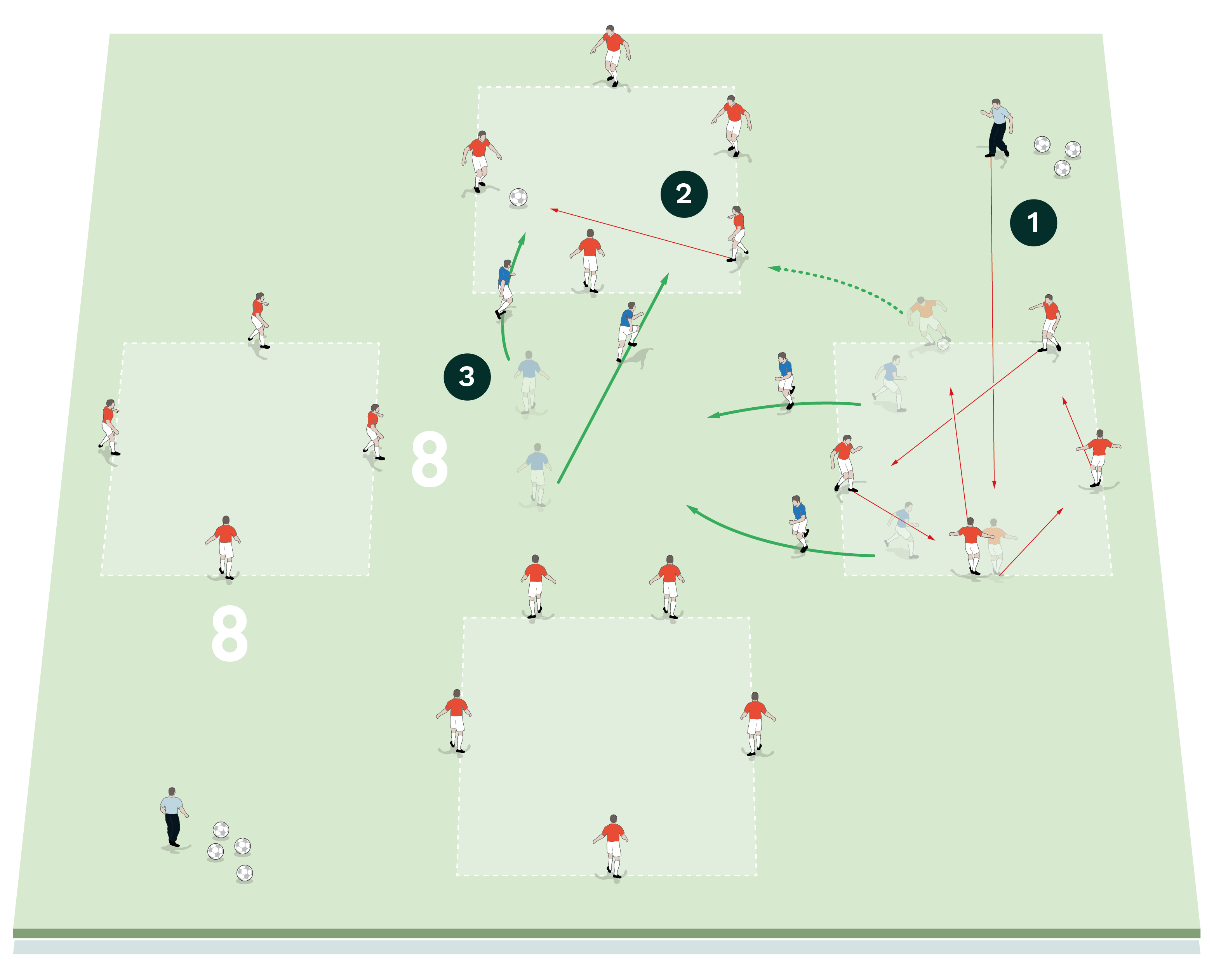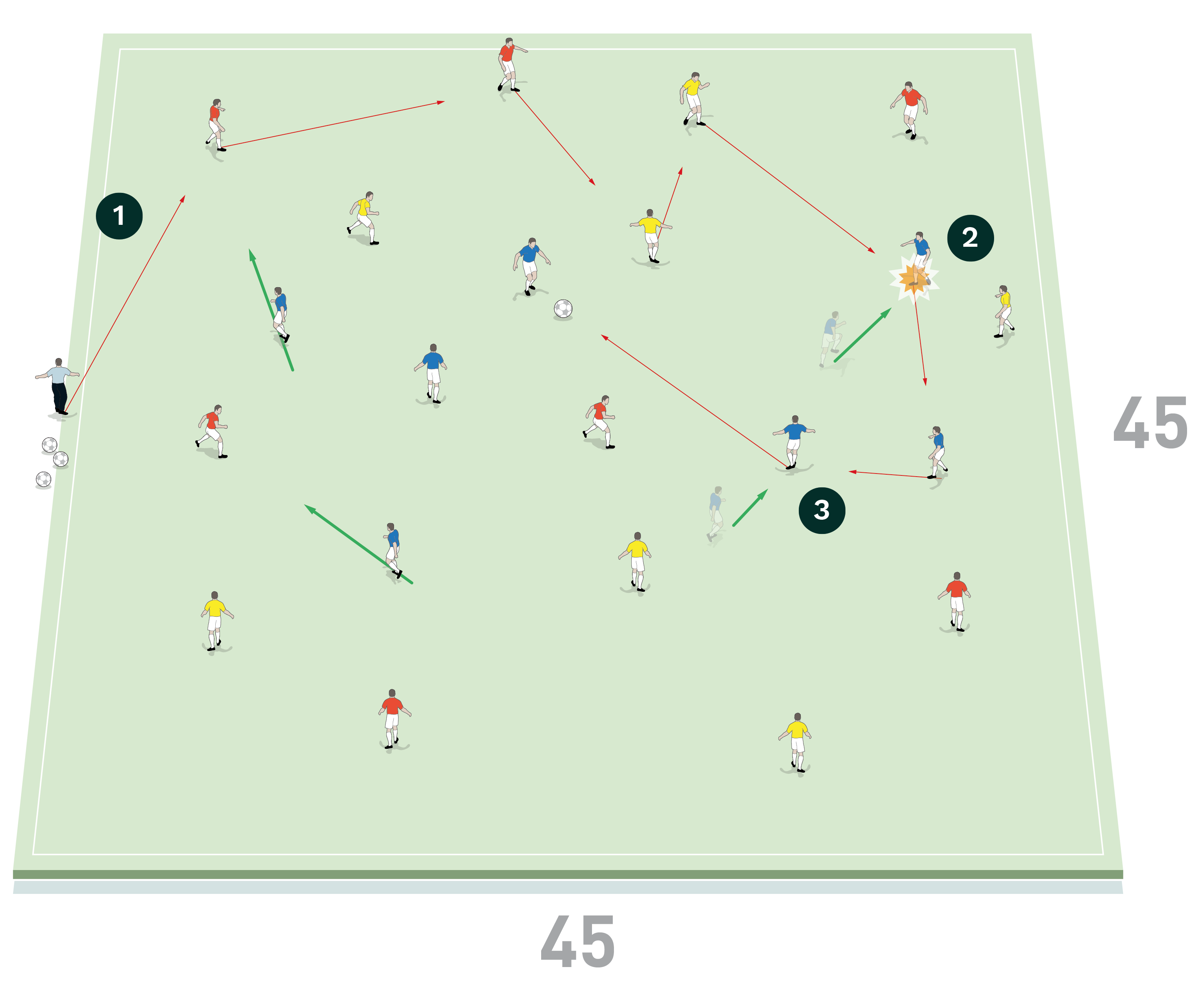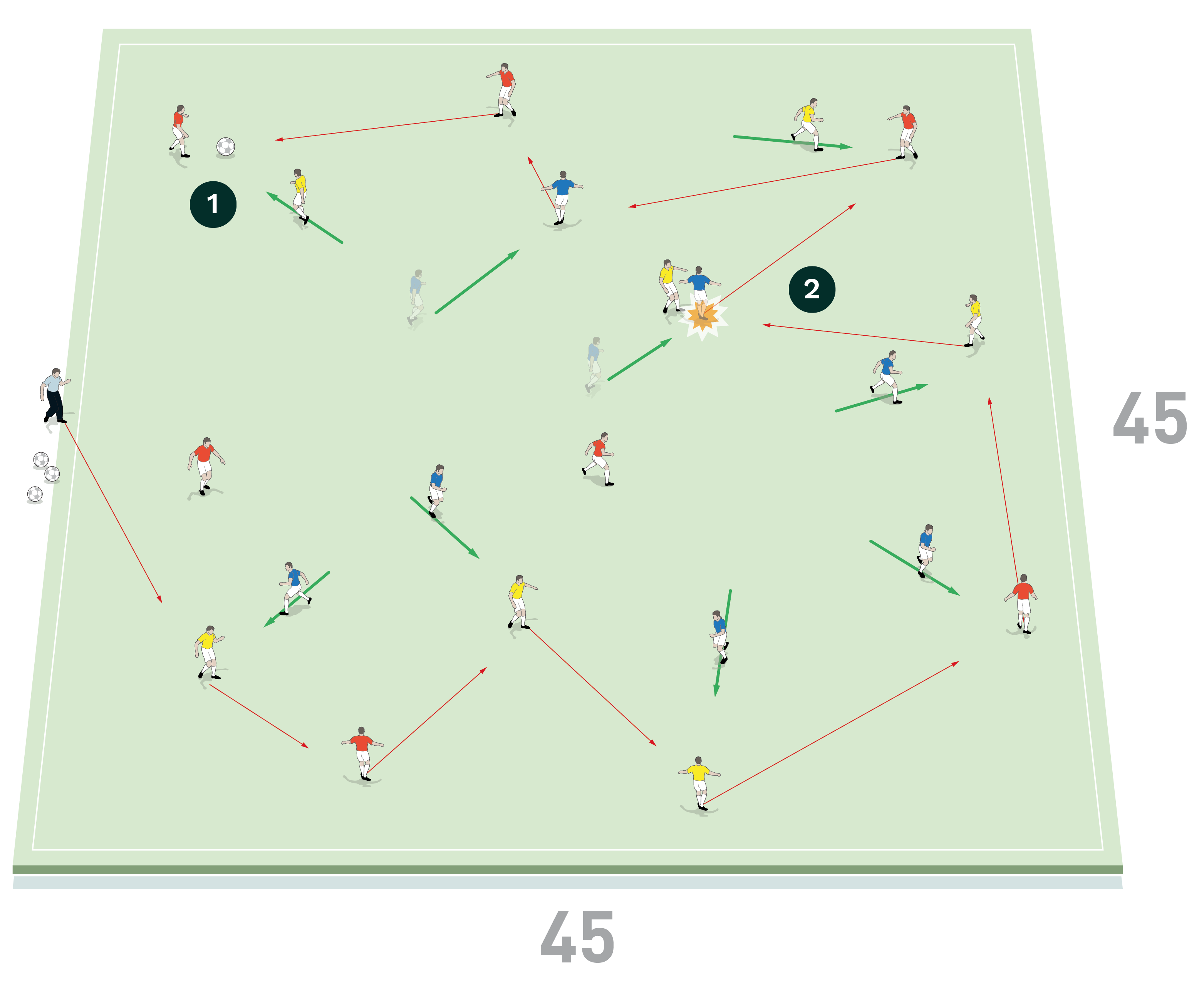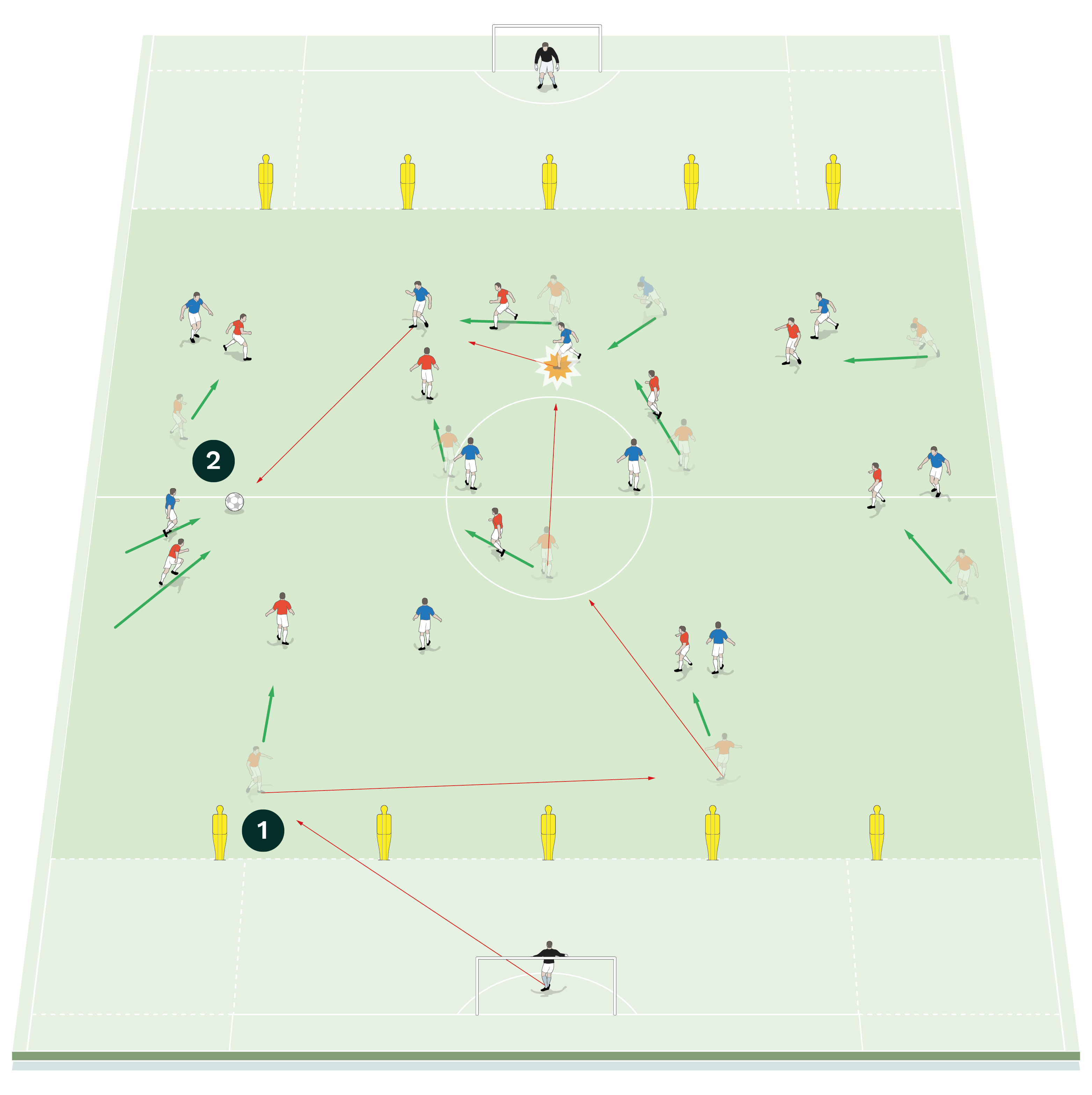




OUR BEST EVER OFFER - SAVE £100/$100
JOIN THE WORLD'S LEADING PROFESSIONAL DEVELOPMENT PROGRAMME
- 12 months membership of Elite Soccer
- Print copy of Elite Player & Coach Development
- Print copy of The Training Ground
Principles of play
| Area | Up to two thirds of pitch |
| Equipment | Balls, bibs, cones, mannequins or poles, 2 full size goals |
| No. of Players | Up to 21 players + 2 goalkeepers |
| Session Time | Rondo boxes: 10mins 14v7 possession practice: 18mins 11v11 possession practice: 18mins |
With our tactical periodisation, we will aim to emphasise all phases of the game on a weekly basis.
The time available to us will dictate the approach we take to training but I always like to do as many global sessions as possible, integrating the technical, tactical, physical, psychological and social elements of the game, along with a sense of competition which is rewarded. Players always respond well when the element of competition is introduced to a session.
These three training exercises presented here are typical examples of the kind of work I like to do at Crystal Palace to reinforce our principles of play to the players and we would run it alongside our position-specific work.
“I like to do as many global sessions as possible, integrating the technical, tactical, physical, psychological and social elements of the game”
RONDO BOXES
We set up four 8x8-yard rondo boxes around a 15-yard central area, as shown. We’re using 21 players, split into 17 passing reds and 4 pressing blues. Four reds start in each of the rondo boxes and an extra red joins one box to start. The four blues begin in the central area between the boxes.
This is essentially a rondo with a run between boxes to add a physical load for the players. The coach starts by passing a ball into the only rondo box that contains five reds. The five red players in that box aim to keep possession of the ball for five consecutive passes against two blue defenders, who rush into the rondo box to apply pressure.
Once the red players have successfully completed five passes, one red player can run the ball out of the box and switch the play into another box. That player then stays in the new box to create a 5v2 situation, with two blue defenders entering the new rondo box as soon as the original two blue pressers have returned to the central area, as shown [1].
We would keep count of the number of possession regains for the defending team in order to create an element of competition.
We want to see the reds showing calmness in possession, using quick one-touch or two-touch passing and making good decisions.
The blue defenders have to work in pairs with intensity, using good communication and making quick recovery runs back into central area.
[1]

2. After the reds make five passes, one red can dribble out of the box and pass into another box. The player then follows the ball into that box and together the reds try to make five passes
3. As soon as the two original blue pressers have returned to the central area, two new blue defenders can enter the new rondo box to press, giving the reds a 5v2 overload again
[2a]

2. One team is designated to defend for 90 seconds. Here the blues press and must try to win possession to score a point
3. If the defending team wins possession and go on to make three consecutive passes between themselves, they score an extra point
[2b]

2. Here the blues win possession from a misplaced yellow pass. The blues join with the reds to pass the ball and the yellows immediately transition into the new pressing team
We set up a playing area of 45x45 yards. We’re using 21 players split into three teams of seven. The coach starts play by passing a ball into one of the three teams. Two teams join forces to pass the ball with a 14v7 overload. The third team is designated to defend for 90 seconds. In block 1, we count the regains of possession and if the ball is won by the defending team and they go on to make three consecutive passes between themselves, then they score an extra point, as shown [2a]. We change the defending team after each 90 second game. We play three games of 90 seconds in block 1, so each team has the opportunity to defend.
In blocks 2 and 3, the team that gives the ball away immediately transitions to become the defending team, as shown [2b]. In both blocks 2 and 3 we play two games of three minutes each.
For this activity to be a success we want to see possession players making the playing area as big as possible and make supporting runs off the ball. The defending team should keep compact and communicate with each other, pressing and covering as both a unit and as a team.
11v11 POSSESSION PRACTICE
We set up between the penalty areas of a pitch with a goal and a goalkeeper in an end zone at each end. Five mannequins are positioned on the edge of each end zone. We’re using 20 outfield players split into two teams of 11 including goalkeepers. The red team is set-up in a 4-3-3 formation and the blue team is set-up in a 4-4-2 system.
The red goalkeeper starts the game and the reds build an attack from the back. The aim for the red team is either to make 10 consecutive passes to score a point or attack centrally to enter the end zone beyond the mannequins. A player can make a run into the end zone to receive a pass and then the player goes 1v1 against the goalkeeper with the aim of scoring, as shown [3a].
[3a]

2. The blue team is set-up in a 4-4-2 system and they must try to win possession to score a point and launch a counter-attack
3. The aim for the red team is either to make 10 consecutive passes to score a point or to try to attack centrally and enter the end zone beyond the mannequins
4. Here a red attacker makes a run into the end zone to receive a pass and then the player goes 1v1 against the blue goalkeeper to try to score
[3b]

2. If the reds lose possession in the build-up they must try to win the ball back within five opposition passes through counter-pressing to score an additional point
“The players should react quickly to the loss of possession and press in small groups and collectively as a team to win the ball back”
We want to see different types of run in behind when attacking and if the team penetrates the defence in one of the wide channels, the striker and the opposite winger can join the attack ready for a cutback.
If a goal is scored in the attack, the red team restarts play from their goalkeeper. If possession is lost in the build-up and the team can win the ball back within five opposition passes in transition through counter-pressing, then an additional point is scored. The players should react quickly to the loss of possession and counter-press in small groups and collectively as a team to win the ball back, as shown [3b]. We play for two games of eight minutes.
Related Files
Editor's Picks
Attacking transitions
Deep runs in the final third
Using the goalkeeper in build-up play
Intensive boxes drill with goals
Penetrating the final third
Creating and finishing
My philosophy
Pressing initiation
Compact team movement
Coaches' Testimonials

Alan Pardew

Arsène Wenger

Brendan Rodgers

Carlos Carvalhal

José Mourinho

Jürgen Klopp

Pep Guardiola

Roy Hodgson

Sir Alex Ferguson

Steven Gerrard
Coaches' Testimonials

Gerald Kearney, Downtown Las Vegas Soccer Club

Paul Butler, Florida, USA

Rick Shields, Springboro, USA

Tony Green, Pierrefonds Titans, Quebec, Canada
Join the world's leading coaches and managers and discover for yourself one of the best kept secrets in coaching. No other training tool on the planet is written or read by the calibre of names you’ll find in Elite Soccer.
In a recent survey 92% of subscribers said Elite Soccer makes them more confident, 89% said it makes them a more effective coach and 91% said it makes them more inspired.
Get Monthly Inspiration
All the latest techniques and approaches
Since 2010 Elite Soccer has given subscribers exclusive insight into the training ground practices of the world’s best coaches. Published in partnership with the League Managers Association we have unparalleled access to the leading lights in the English leagues, as well as a host of international managers.
Elite Soccer exclusively features sessions written by the coaches themselves. There are no observed sessions and no sessions “in the style of”, just first-hand advice delivered direct to you from the coach.







